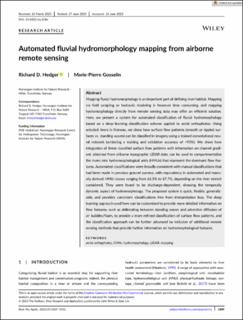Automated fluvial hydromorphology mapping from airborne remote sensing
Peer reviewed, Journal article
Published version

Åpne
Permanent lenke
https://hdl.handle.net/11250/3103179Utgivelsesdato
2023Metadata
Vis full innførselSamlinger
- Publikasjoner fra CRIStin - NINA [2364]
- Scientific publications [1392]
Originalversjon
Rivers Research and Applications: an international journal devoted to river research and management. 2023, 1-13. 10.1002/rra.4186Sammendrag
Mapping fluvial hydromorphology is an important part of defining river habitat. Mappingvia field sampling or hydraulic modelingis however time consuming, and mappinghydromorphology directly from remote sensing data may offer an efficient solution.Here, we present a system for automated classification of fluvial hydromorphologybased on a deep learning classification scheme applied to aerial orthophotos. Usingselected rivers in Norway, we show how surface flow patterns (smooth or rippled sur-faces vs. standing waves) can be classified in imagery using a trained convolutional neu-ral network (achieving a training and validation accuracy of >95%). We show howintegration of these classified surface flow patterns with information on channel gradi-ent, obtained from airborne topographic LiDAR data, can be used to compartmentalizethe rivers into hydromorphological units(HMUs) that represent the dominant flow fea-tures. Automated classifications were broadly consistent with manual classifications thathad been made in previous ground surveys, with equivalency in automated and manu-ally derived HMU classes ranging from 61.5% to 87.7%, depending on the river stretchconsidered. They were found to be discharge-dependent, showing the temporallydynamic aspect of hydromorphology. The proposed system is quick, flexible, generaliz-able, and provides consistent classifications free from interpretation bias. The deeplearning approach used here can be customized to provide more detailed information onflow features, such as delineating between standing waves and advective diffusion ofair bubbles/foam, to provide a more refined classification of surface flow patterns, andthe classification approach can be furtheradvanced by inclusion of additional remotesensing methods that provide further information on hydromorphological features.
